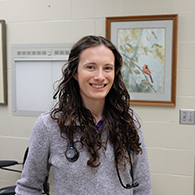Veterinary student publishes report on successful radiation treatment for cockatoo
MANHATTAN — A Kansas State University veterinary student has written and published a case report in a prestigious journal about successful radiation treatment received by a Major Mitchell's cockatoo at the K-State Veterinary Health Center.
"Successful radiation treatment of undertail fibrosarcoma in a Major Mitchell's cockatoo (Lophochroa leadbeateri)" was written by Daria Hinkle, fourth-year veterinary student, Wichita, and published in the Journal of the American Veterinary Medical Association.
The bird was brought to the Veterinary Health Center because of a mass found on its tail. Despite the presence of the mass, the cockatoo was bright, alert and responsive and appeared otherwise healthy. A biopsy was performed by exotic pets and zoological medicine veterinarians David Eshar and Neta Ambar, who was completing an internship in exotic animal medicine at the time. The cockatoo was sent home with medication and to wait for the diagnostic results, which ultimately were inconclusive as to whether the growth was cancerous.
"Once a second biopsy confirmed it to be a malignant type of tumor, we met with Dr. Chieko Azuma from the Oncology Service at the Veterinary Health Center," Hinkle said. "It was recommended that we provide the cockatoo with a course of definitive radiation therapy with the goal of achieving long-term control."
This was a major challenge in this case: The cockatoo stayed at the Veterinary Health Center for four weeks to receive daily radiation treatments under brief, general anesthesia.
"He did great over the course of the hospitalization and almost became the service's mascot," said Eshar, associate professor of clinical sciences at the K-State College of Veterinary Medicine. "Our literature review informed us of previous radiation treatments with other parrot cases that were different than the one we used. We were hopeful that the cockatoo could be treated without excessive adverse effects."
The cockatoo received 20 total radiation treatments, following a protocol similar in scope to radiation treatments for dogs. No chemotherapeutic agents were used. A year and a half after the treatments concluded, the skin in the radiation field appears completely healed with no signs of reoccurrence.
"This is the second time I've been able to write up a case report about the treatment of an avian patient with the help of Dr. Eshar. This publication provides a strong foundation for me as I get closer to pursuing a career in exotic medicine," said Hinkle, who will graduate with her Doctor of Veterinary Medicine degree in May. Hinkle then plans to begin a small animal rotating internship at North Carolina State University and, in the future, pursue residency opportunities in zoo medicine.
Other authors contributing to the report include Eshar, Ambar, Azuma and Sarah Schneider, a former anatomic pathologist at K-State.

